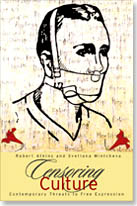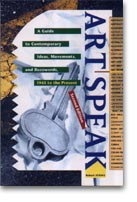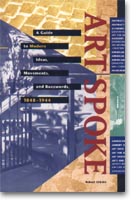
|

|

|






|

|

|

If your idea of censorship is an anonymous bureaucrat in a government office exercising prudish control over "offensive" art and speech, wake up and smell the conglomeration. Censorship today is more likely to be the result of a market force or a bandwidth monopoly than a line edit or the covering of a nude sculpture; and the current system of new technologies and economic arrangements has subtle, built-in mechanisms for suppressing free expression as powerful as any known in other centuries.
In Censoring Culture: Contemporary Threats to Free Expression, Robert Atkins, the well-known author of the ArtSpeak books and, Svetlana Mintcheva, the head of the National Coalition Against Censorship's Art Program, bring together the latest thinking from art historians, cultural theorists, legal scholars, and psychoanalysts, as well as first-person accounts by artists and advocates, to give us a comprehensive understanding of censorship in a new century in which the media-fueled, culture war-scandal is just a diversion from the real action. Like the proverbial canary in the coal mine, the arts may be a barometer for the state of free expression in U.S. society: the methods and mechanisms of censors outlined in this groundbreaking volume already affect each and every American.
Trade Paperback, 2006, U.S., $19.95
The New Press
ISBN: 1-59558-050-6
|

|

Nonplussed by Neo-Geo? Can't tell simulation from semiotics? Forgotten who were the Hairy Who? ArtSpeak is what you need! Its updated and expanded new version includes new entries (such as "culture wars," "online art," and "pathetic art"), new reproductions, and updates to the timeline and earlier entries. More than 115 entries clearly explain the who, what, when, and where of art since 1945.
Some entries deal with concepts, such as formalism, multiculturalism, and the picture plane; some discuss specific movements, such as Abstract Expressionism and Fluxus; some describe various ways of making art, such as collage, performance, and video. Together they provide an invaluable key to the specialized, often baffling vocabulary so often used in today's art world.
These engaging mini-essays—written with wit and common sense—will prove equally useful to novices looking for an introduction to the subject and to professionals in search of specifics.
Complementing the entries are two additional noteworthy features. The first, a one-page ArtChart, presents the movements of the postwar years in a concise format that makes their chronological connections immediately visible. The second is a twenty-eight-page timeline--illustrated with full-color reproductions of paintings, sculptures, and installations--that chronicles events in the art world and the world at large, providing a context for the entries that follow.
Second Edition, Trade Paperback 1997, U.S. $18.95
Abbeville Press
ISBN: 0-7892-0365-0
|

|

An invaluable guide through the intricacies of the first century of modern art, ArtSpoke features the same lucid prose, thought-provoking ideas, user-friendly organization, and striking design as its predecessor, ArtSpeak: A Guide to Contemporary Ideas, Movements, and Buzzwords. Chronicling international art from Realism through Surrealism, ArtSpoke explains such popular but often misunderstood movements and organizations as Impressionism, Post-Impressionism, the Salon, the Fauves, the Harlem Renaissance, and so on-as well as events ranging from the 1913 Armory Show to Brazil's little-known Semana de Arte Moderna.
Concise explanations of potentially perplexing techniques, media, and philosophies of art making-including automatism, calotype, found object, Pictorialism, and Readymade-provide information essential to understanding how artists of this era worked and why the results look the way they do. Entries on concepts that were crucial to the development of modern art—such as androgyny, dandyism, femme fatale, spiritualism, and many others—distinguish this lively guide from any other art dictionary on the market.
Also unique to this volume is the ArtChart, a handy one-page chronological diagram of the groups discussed in the book. In addition, there is a scene-setting timeline of world history and art history from 1848 to 1944, overflowing with invaluable information and illustrated with twenty-four color reproductions.
Trade Paperback published 1993, U.S. $18.95
Abbeville Press
ISBN: 1-55859-388-8
|

|

The catalogue of this ground-breaking exhibition—the first travelling
museum show devoted to AIDS-themed art—was produced by co-authors and curators Robert Atkins and Thomas W.
Sokolowski. It includes not only illustrated entries
devoted to each of the 35 artists and art collectives showcased in the
exhibition, but a wide-ranging dialogue between the authors about art and
activism, memorialization and mass media. The work itself validates the
authors' assertion that AIDS-related work of the late 1980s consititutes, en
masse, one of the most important and artistically engaging bodies of art
produced during the twentieth century. Encompassing the well-known output of
artists ranging from Ross Bleckner to David Woznarowicz, this project also
includes video and conceptual, as well as object-oriented, work from artists
including Nancy Burson, General Idea, Felix Gonzalez-Torres, Gran Fury,
Keith Haring, Robert Mapplethorpe, Duane Michals, and Donald Moffett, among
many others. It also features two additional projects produced for Visual
AIDS's annual Day Without Art: one entitled "The AIDS Crisis: How Can You
Help?" created by the Visual AIDS' Artist Caucus and Group Material's "AIDS
Timeline," which is reprinted from various art magazines as their
contribution to the 1990 Day Without Art.
Published 1991, U.S. $18.00
Independent Curators' Inc.
ISBN 0-916365-34-4
|

|
|

|

|
|
|
|
|

|
|
|
|
© 2006
|
|